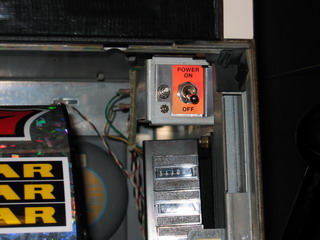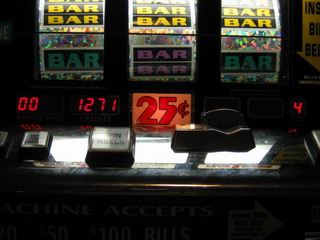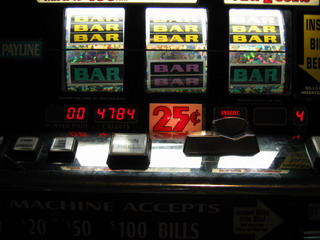|
Okay, so what is all this business about the SP (GAME) chip and SS (REEL) chips? In a nutshell, all S+ game logic is contained into two chips that hold machine functions and game reel definitions and payouts.
The GAME PROM (also known as the "SP Chip") is the chip that holds all machine logic programming. It is essentially the "operating system" software for the S+ hardware. It tells the machine what to do and when to do it. The RNG (Random Number Generator) logic resides here. All setup instructions for the SP/GAME chip are found in a file called a PSR (Program Summary Report). Thus if your game chip is an SP1271, you will nee the PSR1271.doc file to find out the different options for your game chip. This chip does not hold any paytable information or reel strip information. The game options are determinted by this chip in conjunction with the game TYPE as defined by the other chip which is called a REEL chip (also known as the "SS Chip").
The SS/REEL chip holds all the information related to the game kit theme on the machine. It tells the game how the virtual reel stops are configured and the paytable information. All possible winning combinations and their frequency can be found in a file that describes everything there is to know about this chip. This is the PAR (Paytable And Reel strip listing) file, and just like the game chip, the PAR file is named after the chip. So if your Reel chip is an SS4080, the PAR file is SS4080.txt
There are two ways to determine what your game and reel chip are. The first way is, with the power off, to remove your MPU board (that's the silver tray that you see in the game change) and just look for the chips and their labels. Unfortunately, sometimes labels have fallen off, are handwitten poorly, or otherwise cannot be read. That leads to our second method of determining your chip numbers...
The second method does not involve any removal of parts. With the power on, just press the white self test button (typically located next to or behind the power switch) enough times so that a 4 is displayed in the Coins Played window.

The white Self Test button is located to the left of the power toggle switch on this IGT S+ machine.
In the Winner Paid window, you will see two numbers cycle. When the number is flushed to the left of the display, this is the game TYPE. When the number is flushed to the right, it's the first 2 digits of the Reel Prom (most of the time this number is 00, as most reel prom numbers are under 9999). On the Credits window, two numbers will alternate. The first number is the GAME PROM number (this is displayed at the same time the game type is shown on the winner paid window). The second number is the last 4 digits of your REEL chip number. In the example below, you can see [00 ] [1271] and [ 00][4784]. This means that the current game is a type 0 game using an SP1271 game chip and running a SS4784 Reel prom.
 
You can find out what chips are available for your particular game on our on-line game bible. There's also a link in the main page. Select how many coins your game has and look for your game title. You will see a picture of the paytable and belly glass as well as the chip information. It will also tell you what game type it is. Here's a sample line:
| Prog#'s |
Max%
(1st. Coin) |
Hit Freq |
(Stops) |
Top Award
(Hits/Cycle) |
2nd Award
(Hits/Cycle) |
Win Freq |
|
SS4784 |
97.417 (97.059) |
14.234 |
(72)ABC |
1000/2000/4000 (4) |
900/1800/2700 (14) |
7.03 |
The first column displays the chips available, in our sample line, it's the same as the one in the pictures. The number of available reel chips changes depending on the game title.
The second column displays the payback percentage for max coins played and in parenthesis single coin.
It's then followed by the Hit frequency, which is how many times you will get some sort of payout out of every 100 spins.
The next section of information pertains to reel stops. On the S+ there are only 22 reel positions on the physical reel strip, but the REEL table can define up to 512 virtual positions for each reel. This means that any one position on the physical reel can have more than 1 virtual stop, and this is typically the case on most IGT S+ games. On our sample there are 72 stops. This number determines the game cycle, which is the total number of different combinations in the game. A 72 stop game has a cycle of 72x72x72 (stops multiplied by the number of reels), thus this game has 373,248 virtual combinations. This game cycle is merely a description of combinations possible, it does not mean that the game will go 1 combination at a time until it gets to 373,248 and start over, but rather that over several MILLION pulls, mathematically speaking you will hit the top award in this case 4 times every 373,248 spins. The ABC means that all 3 physical strips are different, if all three strips were to be identical it would be AAA. Note that just because the physical strips are alike, does not mean that the virtual stops are the same for all three reels, they are in fact different in all games.
The next section is the top award for each coin played, in this case 3 coins, 3 different awards, followed by the number of top award hits per game cycle.
The next column is the 2nd top award, and again followed by hits per game cycle.
The last number is the win frequency which is an average of how many times you need pull the handle to get a win. The lower this number, the more often the machine pays off. This number is the reciprocal of the Hit frequency. |



